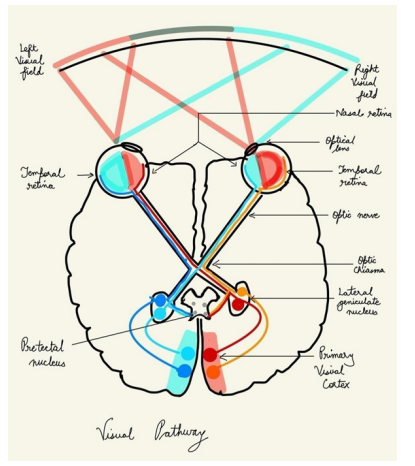Short Communication - (2025) Volume 9, Issue 2
Unique Location of Visual Cortex
Received Date: Mar 20, 2025 / Accepted Date: Apr 22, 2025 / Published Date: Apr 28, 2025
Copyright: ©2025 Ved Prakaash Banga. This is an open-access article distributed under the terms of the Creative Commons Attribution License, which permits unrestricted use, distribution, and reproduction in any medium, provided the original author and source are credited.
Citation: Banga, V. P. (2025). Unique Location of Visual Cortex. J ophthalmol Clin Res, 9(2), 01-02.
Abstract
There are five sense organs, touch is sensed by skin ,sound by the ears,smell by the nose, taste by the tongue and vision by the eyes. It is through the eyes only that we perceive about 80% information of the surroundings, the remaining four are only responsible for 20% information of the surroundings. The eyes are the most vital sense organs, but their even more important role lies in expressing emotions. How they instantly convey love or anger has never been a focus in ophthalmology, even though no other sense organ can express human feelings in the same way.
Importance of Eyes among Five Sense Organs
There are five sense organs, touch is sensed by skin ,sound by the ears,smell by the nose, taste by the tongue and vision by the eyes. It is through the eyes only that we perceive about 80% information of the surroundings, the remaining four are only responsible for 20% information of the surroundings. The eyes are the most vital sense organs, but their even more important role lies in expressing emotions. How they instantly convey love or anger has never been a focus in ophthalmology, even though no other sense organ can express human feelings in the same way.
How the Brain Processes Inputs from the Five Sense Organs
In the central nervous system, different areas of the brain are specialized to analyze the neurological inputs received from the respective sense organs. The auditory area of the brain is responsible for analyzing and perceiving sound signals; it interprets both the category and frequency of sounds. It's not as simple as it seems— how our brain interprets different frequencies and tones often goes unnoticed and fails to capture our attention. Sense of smell travel from Olfactory epithelium to the Olfactory area in brain. Normally we have four million olfactory cells in the nose.Olfactory nerve is the shortest sensory nerve in the human body. Receptors for taste are found in the tongue ,pharynx ,soft palate and the upper portion of oesophagus. Signal travel to the Primary gustatory cortex in the inferior frontal gyrus of the frontal lobe. The primary sensory cortex is located in both hemispheres of the parietal lobes. Sensory touch signals from all over the body are transmitted here and analyzed. Signals from the most vital sense organ, our eyes, travel from the retina to the visual cortex in the occipital lobe. This area anatomically lies directly opposite the origin of the impulse— that is, the eyes.
The Evolutionary Mystery of the Visual Cortex’s Location
What was the evolutionary reason for the visual cortex to lie at the opposite pole relative to the eyes? This arrangement is maximium when compared to other sense organs. The speed of nerve impulses is about 120 meters per second. With the average length of the human brain being 17 cm, it is surprising that the visual cortex lies directly opposite the eyes, while the areas of the brain responsible for other sense organs are located closer to their respective organs.
The visual cortex, where visual signals are analyzed, is located at the farthest possible distance from the eyes. In the event of an impending injury, such as during an accident, this positioning means the body may require more time to react. If the human body is designed in the most intelligent way, why is the visual cortex placed in a way that potentially delays response time and compromises safety?
Although this is not mentioned in modern ophthalmology books, we should still reflect on it. One possible reason might be to provide opportunities for biofeedback from the visual cortex to the eyes. Biofeedback is generated from the visual cortex whenever it is rubbed or touched (the most commonly touched area when we lie down).

Ancient Acupuncture and Modern Medicine: an Untapped Frontier in Ophthalmology
Nowadays, acupuncture is practiced using needles that are usually made of metal. Can you imagine a time when acupuncture originated, back then there was no metal, and the practice was performed using stone needles—some of which are still preserved in museums in China. Just try to imagine—despite the limited technology of that time, the acupuncture points and channels, once dismissed as quackery, are now being validated by modern discoveries like functional MRI. The indications discovered are the same, whether identified by ancient acupuncture practitioners or verified today through functional MRI .
Several vital acupuncture channels flow near the visual cortex and are used in the treatment planning for optic nerve atrophy and injury. Remarkably, even patients without light perception have shown the ability to see following this treatment approach. Until now, TCM channels were considered quackery, but thanks to the advent of fMRI, accepting this might add a new dimension to modern ophthalmology.
References
1. B.D. Chaurasia Volume 4, Edition 8, Chapter 4, Page 64-65.



